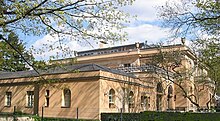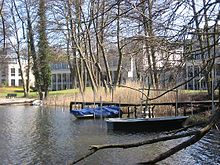Hundekehlesee
| Hundekehlesee | ||
|---|---|---|

|
||
| View to the east bank, left "Villa Konschewski" | ||
| Geographical location | Berlin-Grunewald | |
| Data | ||
| Coordinates | 52 ° 28 '56 " N , 13 ° 15' 32" E | |
|
|
||
| surface | 7.2 ha | |
The Hundekehlesee is located in the west of Berlin's Charlottenburg-Wilmersdorf district on the edge of the Grunewald villa colony and the forest of the same name .
geography
The lake with an area of about 72,000 m² has an elongated shape in north-south orientation and belongs to the glacial channel of the Grunewald lake chain . The lake is fed by the Grunewaldsee in the south via the Hundekehlegraben in the neighboring Hundekehlefenn nature reserve . To the northeast, after around 500 meters, the Dianasee joins the chain of lakes , but the Grunewaldrinne is previously interrupted by three built-up streets and is only noticeable again in a small inconspicuous and nameless park, which is in front of the Dianasee south of Fontanestrasse.
On the west side of the lake there is a public forest hiking trail that continues Berlin's most popular exercise area for dogs, which starts at the Grunewaldsee and continues to the AVUS ( A 115 ). The other sides of the lake are no longer accessible to the public.
history
In 1774 a single fisherman's house, called Hundekehl , was built near Schmargendorf . In 1801 there was a fireplace (= household) there. In 1858 six people lived there; In 1861 there was a residential and two farm buildings in the district.
Until the end of the 19th century, there were walking paths around the lake. But then the Prussian forest treasury sold 12 large plots of land on the eastern shore of the lake to wealthy clients.
There was massive resistance from the colony to the establishment of Greater Berlin in 1920, as the local entrepreneurs, bankers, professors and artists did not want to forego the tax advantages of the rural community of Grunewald.
The district between Hundekehlesee and Dianasee with the streets Gottfried-von-Cramm-Weg / Oberhaardter Weg, Douglasstraße and Gustav-Freytag-Straße is likely to be one of the most upscale areas in Grunewald itself and in Berlin. Many villas resemble small palaces and a large number of buildings and gardens are protected as historical monuments. Almost every building has been restored, many buildings are now divided into several units and rented out. Private individuals and companies have their domicile here.
The pompous villas from the turn of the 20th century and newer modern luxury buildings grouped around the south bank prompted the writer and poet Robert Gernhardt to read the lines in the journal Kursbuch in 2001 on the subject of "The Envy Society" in the article early summer evening at Hundekehlesee :
Oh that nobody told the poor that
they didn't even have to eat their way through porridge.
The
land of milk and honey would be
right around the corner:
"It's only up to you to get there"
By the time the new embassy district was completed in the city center, several embassies such as those of Ireland and the Czech Republic were also located.
Neighbors
Direct neighbors include the equestrian squadron of the Federal Police and the LTTC Rot-Weiß Berlin tennis club with the Steffi Graf Stadium , which is located above the lake and was named after the player by Steffi Graf in September 2004 after an exhibition match .
Villa Harteneck
A particularly luxurious example of these buildings is the Villa Harteneck, which was built between 1910 and 1912 based on designs by Adolf Wollenberg for the chemical manufacturer Carl Harteneck. During the time of National Socialism , the head of the Foreign Office / Defense in the High Command of the Wehrmacht, Admiral Wilhelm Canaris , lived there after the assassination attempt on Hitler on July 20, 1944, together with opponents of the regime Dietrich Bonhoeffer and Hans Oster on April 9, 1945 in the Flossenbürg concentration camp was executed. After a restoration between 1981 and 1985, part of the villa was the embassy residence of South Africa until the beginning of the 21st century . The extensive park of the villa, which is protected as a garden monument, extends to the public park on Fontanestrasse, which, with its bent course and channel shape, indicates the former course of the Grunewaldsee chain between Hundekehlesee and Dianasee.
Konschewski Villa
Another impressive building is the multi-part and restored Villa Konschewski from 1923 on Gottfried-von-Cramm-Weg 33-37, whose extensive and protected garden extends down in terraces to the east bank of the lake. The client was Moritz Konschewski, director of a Pomeranian paper mill. The monument is sometimes referred to as the “Oskar Kaufmann Villa” after its architect , who built the Hebbel Theater in 1908 and the Volksbühne in 1914, and who built the Renaissance theater in 1927 . The Hungarian architect Oskar Kaufmann has similar with Villa Konschewski the Renaissance Theater an art deco building created with elements of the neo-Rococo is mixed. During the complete renovation in the 1990s, with the consent of the State Conservator , the Remise building was torn down and replaced by a new building. Today the villa is divided into several units.
Dog Quele or Rotsee
The first mention as "Hundekehl, Einzel Fischerhauß bei Schmargendorff" can be found in 1774 in the Typographische Nachrichten von der Mark Brandenburg . From 1805 there is a description as "Hundekehl, forester's house belonging to Dahlem." Today's magnificent forester's house "Hundekehle" is located around 200 meters south of the Hundekehlefenn.
There are two possible explanations for the origin of the name "dog throat":
- According to the Luisenstädtischer Bildungsverein , the name is derived from the old term "Hundquele" as a collection point for packs of dogs during the driven hunt . According to this explanation, this collection point would have been in the neighboring Hundekehlefenn, which would have given the lake its name. This version speaks on the one hand the proximity of the hunting lodge Grunewald on the neighboring Grunewaldsee, on the other hand the "Hundekehlestrasse" in the district of Schmargendorf , because this street was still called around 1890 "hundqueleweg "
- According to Gerhard Schlimpert , name researcher for the Teltow , this version apparently goes back to suggestions made by Herrmann Patzig in 1926. Since there are no references to the name of the lake before the 18th century, Patzig assumed that the Hundekehlesee was identical to the "Rotsee" mentioned in 1567 and half the "Rotsehe" in 1598. Patzig associated the name with the establishment of a dog house. However, since there is no evidence for this, Schlimpert believes, after several comparisons of terms (for example “Silberkehle”), as an alternative, the determinant dog could belong to the Middle Low German hunt for measure, acre measure, 1/6 acre and brings Kehle to the Middle Low German kele , keel for gorge, mountains in connection.
literature
- Gerhard Schlimpert : Brandenburgisches Namenbuch, Part 3, Die Ortnames des Teltow , Hermann Böhlaus Nachf., Weimar, 1972, on the term "Hundekehle" p. 226. There also quotations on the name 1774 and 1805 from the Typographische Nachrichten von der Mark Brandenburg .
- Herrmann Patzig: Old place names in the west of Greater Berlin, their origin and their meaning. Berlin 1926. Here reproduced from: Gerhard Schlimpert…, see above.
- The envious society. Kursbuch, booklet 143. Ed. Karl Markus Michel u. a., Rowohlt Verlag, Berlin 2001, ISBN 3-87134-143-6 .
- Lieselott Enders : Historical local lexicon for Brandenburg: Teltow (= Historical local lexicon for Brandenburg . Volume 4). Verlag Hermann Böhlaus successor, Weimar 1976.
Web links
- House Konschewski Senate Department for Urban Development
- Overview of contents of course book No. 143 from 1999 ( Memento from March 26, 2005 in the Internet Archive )
- Hundekehlestrasse. In: Street name lexicon of the Luisenstädtischer Bildungsverein (near Kaupert ) - term dog quele
- Hundekehlensee / The Grunewald in the mirror of time
Footnotes
- ^ Negotiations of the Second Berlin Forest Protection Day . In: Berliner Waldschutzverein (Ed.): The fight for our forests . Springer, Berlin 1909, pp. 5–41, here p. 18.





